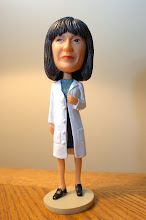Here we are at sucralose, the last of the 5 FDA approved non-nutrative, high intensity sweeteners and currently the most popular sweetener used in the US. Sucralose is a relatively new sweetener as they go; it was discovered in 1976 when 2 scientists were working with chlorinated sugars as intermediates for other compounds. The story is that one chemist asked the other to 'test the compound' but the other chemist misheard it as 'taste the compound'. Now, I can't verify the validity of this story (and it suggests a serious lapse in judgment and some really bad lab practices on the part of the second chemist), but we do know that someone tasted the compound and discovered it to be really sweet. 600 times sweeter than sugar to be exact. Over the next 20 years, a considerable amount of testing was performed on both animals and humans (~110 studies) before the FDA approved it for limited use in 1998, followed by approval for general use in 1999. It is sold under the trade name Splenda.
If you've been reading about the other sweeteners in this series, I'm sure you're aware there is a controversy about the safety of these types of products and sucralose is no exception. Let me start with this caveat - I've "no horse in this race"; I don't make these products, nor do I make any money from them, I just want to pass on my knowledge of these products so you can make informed decisions. There is a lot of chemistry involved here, so I'll try to make it understandable.
Sucralose uses sugar as its starting material, although theoretically other chemicals (and yes, sucrose is a chemical) could be used. On the sucrose molecule 3 hydroxyl (-OH) groups are replaced with 3 chlorine (-Cl) atoms to make the sucralose molecule (aka - trichlorogalactosucrose or chlorinated sugar). Sucralose belongs to a class of chemicals known as organochlorides. Organochlorides are organic compounds that contain at least one covalently-bonded chlorine atom. Now, it is because sucralose is an organochloride that most of the controversy exists. Let me give you some background - each of these statements are equally true:
- Some organochlorides are toxic
- Some pesticides, including DDT, are organochlorides
- Organochlorides are fat soluble and can accumulate in our fatty tissues over time
- Some organochlorides are naturally occurring
- Some things we eat (well, that I eat) contain organochlorides like seaweed
- 165 organochlorides are approved worldwide for use in pharmaceutical drugs including Claratin and Zoloft
There is also some concern, though no proof at this point, that chronic consumption over many years could result in shrinkage of the thymus, a result seen in rats when fed the equivalent of 20,000 packets per day for one month. You see, there are those out there who think that because sucralose is an organochloride it should be considered toxic and subject to far more scrutiny than other compounds. There are also those who feel that all man-made chemicals are suspicious. You may fall into one or both of these categories which is fine by me, but here's my take on this product.
Sucralose is mostly undigested, meaning it leaves our body in the same way it comes in. And it has been shown through research that the chlorine atoms are not cleaved off the molecule in our bodies. However, between 2-8% of sucralose is metabolized (the metabolites are glucuronides). So why don't I worry about those metabolites? Well, sucralose is water-soluble not fat-soluble, so the threat of it depositing in our fatty tissues is pretty remote. And in addition to our FDA, the World Health Organization (WHO), the EU, Canada and others have all weighed in on the safety issue and agreed that it poses no hazard at levels equal to 75 packets per day. Given that these people hold advanced degrees far above mine, I'm willing to go with their vote.
If you've now decided that this sweetener is a-ok with you, what else should you know about it? It is heat stable, so it can be used in baked goods and canned goods like jellies. And while it contributes no calories, this is due to its small usage rate because of its intense sweetness. Those Splenda packets do have calories due to the dextrose and maltodextrin they contain as bulking agents (used to dilute the sucralose). There are really 3 calories per packet, but the FDA allows the claim of 'zero calories' because of how the rules are written. [allowed to state zero calories on food containing less than 5 calories per reference amount customarily consumed and per labeled serving]. Sucralose is safe for diabetics to use and it is often used as a blend with acesulfame potassium and aspartame.
Whew! I know this topic has been a long one, but sometimes food literacy requires a lot of information. I hope that you now have a new take on non-nutrative, high intensity sweeteners and that I either confirmed your suspicions or alleviated your concerns. There are some other sweeteners out there awaiting approval, used as food supplements, and/or allowed outside the US which I will talk about next week!





No comments:
Post a Comment